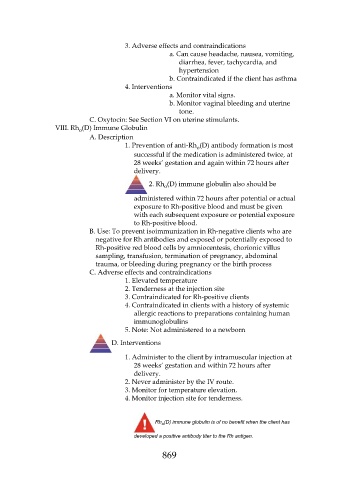Page 869 - Saunders Comprehensive Review For NCLEX-RN
P. 869
3. Adverse effects and contraindications
a. Can cause headache, nausea, vomiting,
diarrhea, fever, tachycardia, and
hypertension
b. Contraindicated if the client has asthma
4. Interventions
a. Monitor vital signs.
b. Monitor vaginal bleeding and uterine
tone.
C. Oxytocin: See Section VI on uterine stimulants.
VIII. Rh (D) Immune Globulin
o
A. Description
1. Prevention of anti-Rh (D) antibody formation is most
o
successful if the medication is administered twice, at
28 weeks’ gestation and again within 72 hours after
delivery.
2. Rh (D) immune globulin also should be
o
administered within 72 hours after potential or actual
exposure to Rh-positive blood and must be given
with each subsequent exposure or potential exposure
to Rh-positive blood.
B. Use: To prevent isoimmunization in Rh-negative clients who are
negative for Rh antibodies and exposed or potentially exposed to
Rh-positive red blood cells by amniocentesis, chorionic villus
sampling, transfusion, termination of pregnancy, abdominal
trauma, or bleeding during pregnancy or the birth process
C. Adverse effects and contraindications
1. Elevated temperature
2. Tenderness at the injection site
3. Contraindicated for Rh-positive clients
4. Contraindicated in clients with a history of systemic
allergic reactions to preparations containing human
immunoglobulins
5. Note: Not administered to a newborn
D. Interventions
1. Administer to the client by intramuscular injection at
28 weeks’ gestation and within 72 hours after
delivery.
2. Never administer by the IV route.
3. Monitor for temperature elevation.
4. Monitor injection site for tenderness.
Rh (D) immune globulin is of no benefit when the client has
o
developed a positive antibody titer to the Rh antigen.
869

